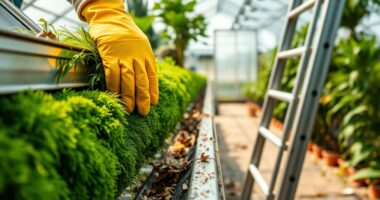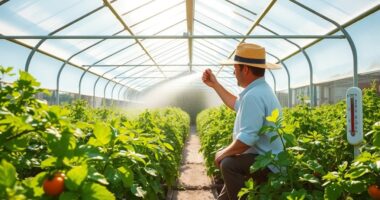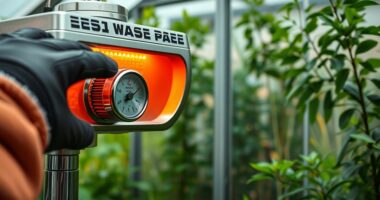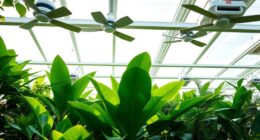To keep your greenhouse thriving, regularly inspect and clean ventilation fans and filters, monitor humidity and soil moisture levels, and make certain lighting and irrigation systems work properly. Conduct pest checks and address issues immediately with integrated control methods. Practice pruning and proper watering to promote healthy growth. Maintain a detailed schedule and record your activities to prevent problems before they develop. Continue exploring these essential tasks to optimize your greenhouse environment and plant health.
Key Takeaways
- Regularly inspect and clean ventilation systems, fans, and filters to ensure proper airflow and humidity control.
- Conduct routine pest inspections and implement integrated pest management strategies promptly.
- Monitor and adjust environmental factors such as soil moisture, humidity, and light exposure for optimal plant health.
- Schedule consistent maintenance for irrigation, lighting, and ventilation equipment, and keep detailed records of activities.
- Practice pruning, debris removal, and timely replacement of equipment to promote healthy growth and prevent issues.
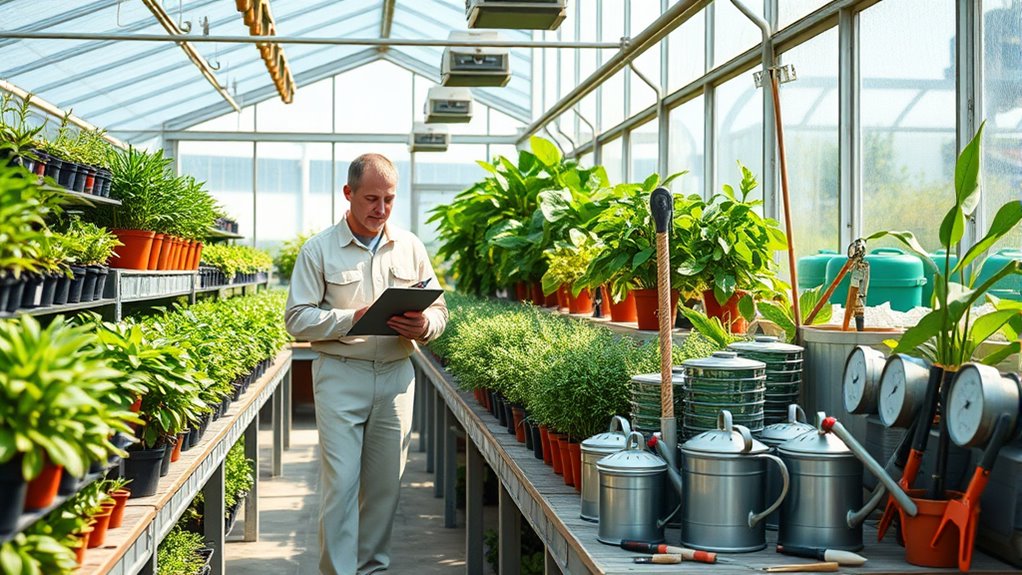
Ever wondered how to keep your greenhouse running smoothly year-round? Maintaining a healthy environment inside your greenhouse requires attention to several key tasks, especially when it comes to ventilation systems and pest control. Proper ventilation is essential for regulating temperature, humidity, and air circulation. You need to regularly check that your ventilation systems are functioning correctly, ensuring fans and vents open and close as they should. Clean dust and debris from fans and filters to prevent blockages that could reduce airflow. Good airflow helps prevent mold, mildew, and fungal diseases while also reducing the risk of pests settling in your plants. Speaking of pests, pest control should be an ongoing priority. Regular inspections are crucial to catch infestations early before they spread. Look for signs like chewed leaves, discolored spots, or webs, and act swiftly with appropriate treatments. Integrated pest management strategies work best; combine biological controls, such as beneficial insects, with organic or chemical treatments when necessary. Keep your greenhouse clean by removing dead plant material and debris that can harbor pests and diseases. Maintaining a tidy environment discourages pests from making your greenhouse their home. Additionally, maintaining proper ventilation systems helps regulate humidity levels, which is vital for preventing fungal issues. Regularly checking that your soil moisture levels are appropriate can further reduce disease risks and promote healthy plant growth. Moreover, monitoring light exposure ensures that your plants receive consistent and adequate illumination, supporting photosynthesis and growth.
Aside from ventilation and pest control, you should routinely check your irrigation system for leaks or blockages to guarantee your plants receive consistent moisture. Overwatering or underwatering can stress plants and attract pests, so precise watering is essential. Monitor the health of your plants, watching for early symptoms of disease or nutrient deficiencies, and address issues immediately to prevent outbreaks. Proper fertilization, based on soil tests, supports vigorous growth and resilience against pests and diseases. Regular pruning also promotes good air circulation within plants, reducing the chances of fungal infections and making pest detection easier.
Lighting is another crucial factor. Ensure your grow lights are functioning properly, and replace bulbs as needed to maintain ideal light levels for your crops. In addition, keep a detailed maintenance schedule and record all inspections, treatments, and repairs. This helps you stay organized and catch recurring problems early. Remember, a proactive approach to greenhouse maintenance saves you time and money in the long run. Consistently maintaining your ventilation systems and pest control measures creates a balanced environment that promotes healthy plant growth and minimizes issues. By staying vigilant and adhering to your checklist, you’ll foster a thriving greenhouse where plants flourish all year long.
Frequently Asked Questions
How Often Should Greenhouse Fans Be Inspected and Cleaned?
You should inspect and clean your greenhouse fans regularly to guarantee optimal fan maintenance and a proper inspection schedule. Ideally, check fans at least once a month to remove dust and debris that can hinder airflow. More frequent inspections are necessary during high pollen or dust seasons. By maintaining a consistent inspection schedule, you prevent potential issues, extend your fans’ lifespan, and keep your greenhouse environment healthy for plants.
What Are Signs of Ventilation System Failure?
Ever wondered what signals ventilation system failure? You might notice persistent hot spots, lingering humidity, or uneven temperature distribution—clear signs of airflow issues. If your ventilation failure causes poor airflow, plants could suffer from mold or stunted growth. Keep an eye out for strange noises or reduced fan performance. Regular inspections help catch these issues early, ensuring your greenhouse maintains ideal conditions for healthy, thriving plants.
How Can I Prevent Mold Growth in My Greenhouse?
To prevent mold growth in your greenhouse, focus on humidity control by maintaining consistent, ideal levels. Use mold-resistant materials for surfaces and containers to reduce mold chances. Guarantee proper ventilation to keep air moving and moisture levels down. Regularly clean and remove any dead plant matter or debris, which can harbor mold spores. These steps create an environment less hospitable to mold, promoting healthier plants and a thriving greenhouse.
What Is the Recommended Temperature Range for Greenhouse Maintenance?
You should aim to keep your greenhouse temperature between 65-75°F for ideal plant growth. Proper temperature regulation helps prevent stress and disease, while humidity control reduces mold risk. Use ventilation or fans to maintain consistent temperatures, and monitor humidity levels regularly. Adjust heating or cooling systems as needed to stay within this range, ensuring your plants thrive and your greenhouse stays healthy.
How Do I Identify and Fix Leaks in Greenhouse Glazing?
Think of your greenhouse like a ship needing a watertight hull. During glazing inspection, look for cracks, fogging, or discolored spots that signal leaks. Once identified, perform leak repair by sealing small cracks with greenhouse-specific sealant or replacing damaged panels. Regularly checking your glazing guarantees your greenhouse remains a healthy environment, just like maintaining a sturdy vessel keeps it afloat and thriving.
Conclusion
By following this greenhouse maintenance checklist, you’ll keep your plants happy and healthy, just like a seasoned gardener tending to their herbs in a Victorian greenhouse. Stay consistent with inspections, cleanings, and repairs—think of it as your secret recipe for a thriving oasis. Remember, a well-maintained greenhouse is your sanctuary for growth and fresh harvests. So, don your gardening gloves and embrace the timeless joy of nurturing life—your green thumb’s best hour is now!


